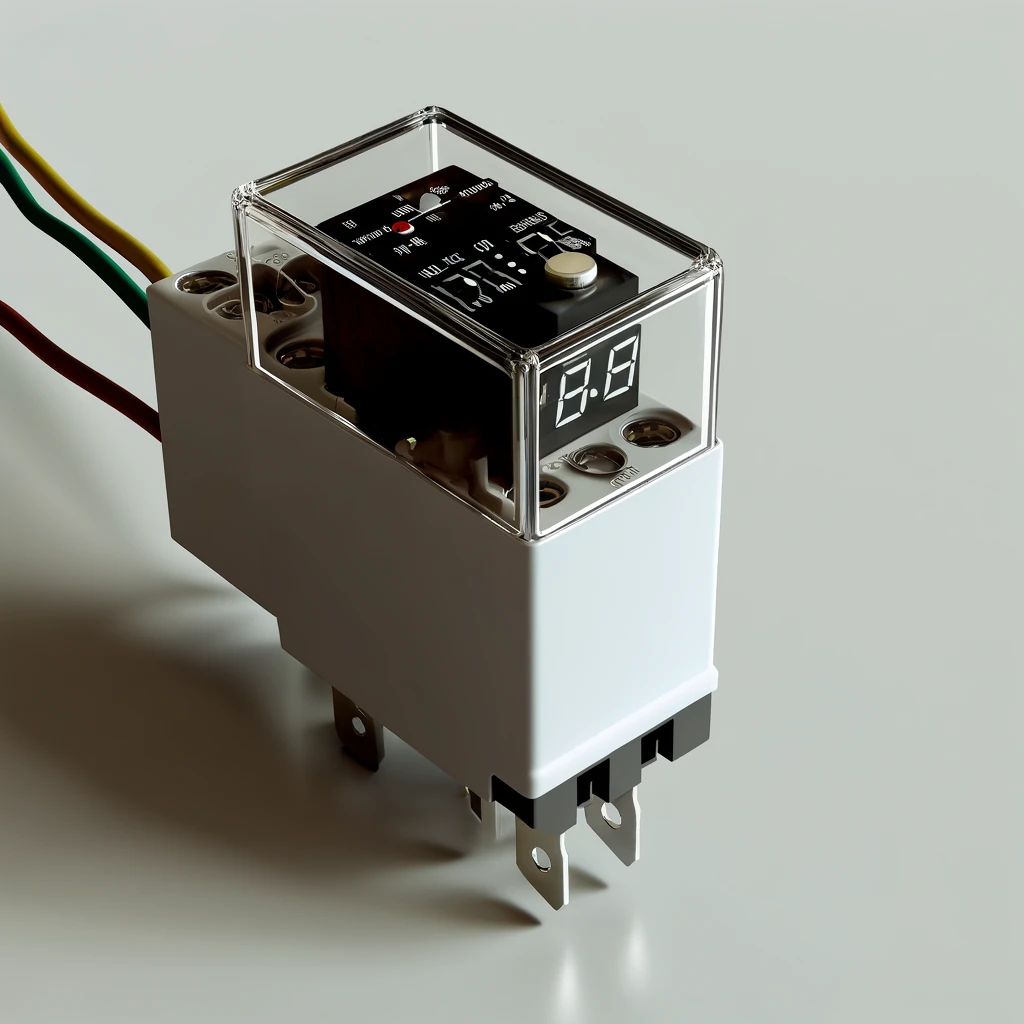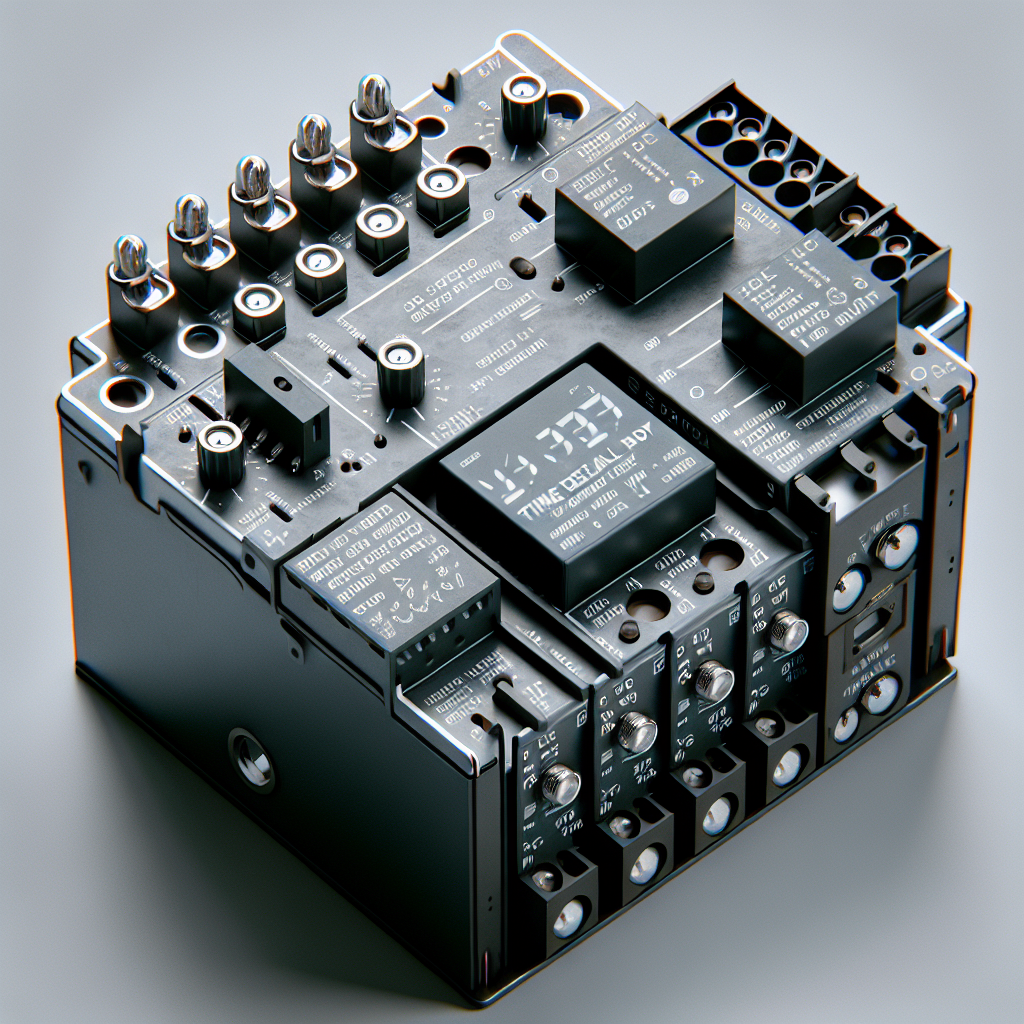Let’s Talk Time Delay Relays
Have you ever wondered about the mechanism that makes sure your dryer doesn’t overheat or keeps the industrial machinery you’re handling from overloading?
This unsung hero working silently behind the scenes is a ‘Time Delay Relay’. It may not sound glamorous, but its applications ripple across countless domains from construction to manufacturing.
But what exactly is a time delay relay and why is it crucial in varying industries? We’re about to reveal the mystery behind this important tool.
Before embarking on this journey of understanding, let’s comprehend a notable statistic – nearly 60% of catastrophic machinery failures could be prevented with the accurate and consistent application of time delay relays.
From regulating the timing of electrical circuits to preventing system overloads, this tiny device resolves significant challenges in not only equipment safety but also in enhancing process controls.
Table of Contents

How Does a Time Delay Relay Work?
Time delay relays – they’re a fundamental component in various construction and manufacturing settings, but just how does a time delay relay work? Buckle up as we simplify this complex concept.
What is a Time Delay Relay?
Firstly, let’s break down what we’re dealing with here. A time delay relay is an electromechanical device that provides a simple yet effective means of controlling the timing of electrical circuits.
It essentially performs two tasks: turning on or off power to a device at specific, pre-set time intervals.
Components of a Time Delay Relay
Let’s get to know the main players in a typical time delay relay.
Input Power Source
Provides the energy needed to initiate the timer functions.
Control Switch
Acts as the user interface and allows for the adjustment of time delays.
Electronic Timer
The core of the relay that’s responsible for the timing function.
Relay Output Contact
The switch that turns on or off power to the load/control device.
How a Time Delay Relay Works
So now we’ve established what a time delay relay is and its main components, let’s dig into the nitty-gritty detail of how it works.
Step 1: Powering Up
When power is applied to the input source, the electronic timer starts counting.
Step 2: Time Delay Action
The time delay is activated when a signal is received by the control switch. The pre-set delay starts counting down.
Step 3: Relay Output Activation
Once the pre-set time has elapsed, the relay output contact either switches power on or off to the control device.
Applications of Time Delay Relays in Construction
Now that we understand how a time delay relay works, you might be wondering where these mechanisms are applied in the construction industry. They are used in numerous machinery control systems and processes which require precise, timed control mechanisms such as crane operations, HVAC systems, and lighting controls.
While understanding the functionality of a time delay relay might seem daunting at first, breaking down the process into manageable steps helps to dispel the complexity.
Could it be that the biggest task is not understanding the concept but rather putting it into practical use?
Explore the time delay relay in action to better understand how this simple but ingenious device works.

The Purposes of a Time Delay Circuit
In this segment, we’ll get into the fundamental purpose of a time delay circuit and its importance in various domains. Let’s expand more on why and where the need for a time delay relay emerges.
Why Use a Time Delay Relay?
The key purpose of a time delay circuit is to introduce a delay or time interval between the activation of one component and other subsequent elements in a circuit.
The importance of this delay lies behind providing an opportune moment for other parts of the circuit or system to respond adequately to the input before the next phase kicks in.
Advantages of Time Delay Circuits
So, what are the benefits of adding this delay?
Preventing System Overloads:
By providing a staggered start-up, it prevents a simultaneous switch on of all components which could potentially overload the system.
Increased Safety:
Delays in circuit controls can add a margin of safety, particularly in industrial machines and processes.
Better Process Control:
In complex systems and processes, precise timing ensures smoother operations and enhanced output.
Where Are Time Delay Relays Used?
We have seen their use in construction settings, but where else might you encounter a time delay relay?
Automotive Systems
They’re used in vehicle systems such as in retractable headlights and time-delayed windshield wipers.
Home Appliances
In your home, time delay relays are found in appliances like washing machines, dryers and dishwashers to control cycles.
Sound Systems:
They’re also used in sound systems to create echo effects. Aren’t you amazed with all the places where a time delay relay plays a pivotal role?
Additional Features of Time Delay Relays
Advancements in technology have introduced additional features to these pivotal devices. Modern time delay relays possess digital timers that allow for more precise adjustment of delay periods.
They can also be switch programmed or remotely controlled via a computer, further enhancing convenience and efficiency in operation.
Selection Guidelines for Time Delay Devices
While choosing a time delay relay, consider factors like time range, number of timing ranges, timing function, voltage and current ratings, number of outputs, mounting options, and environmental conditions it can operate in.
Summing it all up
The purpose of a time delay relay is more nuanced than just “turning devices on and off.” From preventing overloads to enhancing safety and control, time delay circuits play a major role in many areas of our lives.
So, could it be that these underrated devices are the unsung heroes of our day-to-day operations?

How do you select the Ideal Counter Functions for your Time Delay Relays?
Step by Step Guide to Choose the Right Counter Functions for Time Delay Relays
Every time delay circuit is unique, and it becomes crucial to select the right relay with counter functions compatible with your circuit’s requirements. Let’s explore how!
Step 1: Identify your Need
Your need defines the counter function you choose. Do you need time-delayed start-ups for safety or controlling operational sequences? Answering such questions will lead you towards the appropriate counter function.
Step 2: Evaluate your Circuit’s Parameters
Description of your circuit’s voltage, current, timing ranges, and environmental conditions is crucial. Compatibility assessment of these factors with relays ensures your time delay relay functions optimally.
Step 3: Choose the Right Counter Function
Counter functions vary from repeated cyclic timing to single-delay-on-make or single-delay-on-break. The chosen function should align with your circuit’s demands and desired output.
Types of Counter Functions
Understanding the rudiments of common counter functions can ease the decision-making process.
ON-Delay Timing
The delay starts when power is applied. The relay will operate after the delay period.
OFF-Delay Timing
The relay operates immediately when power is applied, and will release only after power is removed and the delay period concluded.
Interval Timing
The relay operates when power is applied, the interval begins, and the relay releases after completion of the interval.
Differences between Solid State Relays and Electromechanical Time Delay Relays
Solid State Relays vs Electromechanical Time Delay Relays
While we’re on the subject of time delay relays, have you ever wondered about the differences between solid state relays and electromechanical time delay relays? Both serve similar functions but differ substantially in the way they operate and their applications.
| Solid State Relays | Electromechanical Time Delay Relays |
|---|---|
| Use semiconductor devices for switching | Rely on physical mechanisms for switching |
| Silent operation | Generate noise due to electromechanical operations |
| No contact bounce | Possibility of contact bounce |
| Longer life cycle | Shorter life span due to mechanical wear and tear |
Simply put, your choice between the two would largely rely on the specific requirements of your application.
The Time Delay Relay Takeaway
Time delay relay, the little big hero, is not merely a staple component in various systems but an integral part of ensuring operational efficiency and safety.
The complexity of understanding them lies in the fact that each system may require a unique type of relay.
However, once you grasp the basics, making a smart choice wouldn’t be a daunting task any longer. Isn’t it interesting how understanding this pint-sized device can make a significant difference in successful circuit design?

How Do You Troubleshoot a Timer Relay?
Armed with a good understanding of a time delay relay’s functioning and its roles, the next crucial step is knowing how to troubleshoot it.
So, what happens when a timer relay malfunctions? Let’s break it down.
Common Issues with Timer Relays
Knowing potential problems are half the job done. Let’s look at the common issues you may encounter with timer relays and how to identify them.
No Activation:
If the relay is not activated after the delay, it is an indication of an internal timer issue.
False Activations:
Unwanted activations suggest a problem with the input signals or the relay’s internal circuits.
Inconsistent Time Delays:
If the delay period is inconsistent, it might imply a problem with the control switch or the electronic timer.
Step by Step Guide for Timer Relay Troubleshooting
Now that we know some of the common issues, let’s see how to approach troubleshooting them.
Step 1: Safety First
Before you start, ensure that you are following safety protocols. Mishandling electrical devices can be harmful.
Step 2: Check for Visible Damages
Begin by checking the relay for any visual indications of damage. Sometimes, the problem might be as simple as a broken or loose wire.
Step 3: Test the Input Power Source
Ensure that the power source is working correctly. A malfunctioning power source could be the trigger for the issue.
Step 4: Inspect the Output Contact
If the relay output contact is dirty or damaged, it could affect switching.
Step 5: Validate Control Switch and Timer
Lastly, validate the control switch and timer settings. Misconfigurations can lead to false activations or inconsistent delays.
Implementing the Time Delay Circuit
Now that we’ve discussed the purpose, features, selection, and troubleshooting of a timer relay, let’s finally dip our toes on how to implement these devices in real-life scenarios.
Practical Guide on Using Timer Relays
Given all the contexts where timer relays are used – automotive systems, household appliances, industrial equipment, and more, you might wonder how these devices are practically applied? Let’s go through a universal guide on how to use them.
Identify the Requirements:
The first step is identifying what kind of delay your system requires. Is it an ON-delay, OFF-delay, or an interval delay? Once determined, you can select the appropriate timer relay.
Set Up the Time Delay:
Depending on the type of relay and application, program the desired delay time using the control switch/display.
Wire the Relay:
Connect the relay to the circuit following the manufacturer’s wiring diagram.
Test the Setup:
Test the setup to validate proper functioning before leaving it to work independently.
Do’s and Don’ts When Implementing Timer Relays
Like with every electrical device, there are certain do’s and don’ts when implementing timer relays.
Do:
Always follow the manufacturer’s schematics and specifications when wiring the relay to the circuit.
Don’t:
Never disregard safety precautions while working with these devices.
Do:
Routinely check and maintain the timer relays to ensure optimal performance.
Don’t:
Avoid deploying timer relays in conditions not suitable for their specifications.
Understanding the importance and practical applications of a time delay relay helps us appreciate how this seemingly complex device simplifies functionalities to ensure smooth operations in various applications – be it home appliances, commercial machinery, or even our cars.

Times Up On Time Delay Relays
After an enlightening trek into the realm of time delay relays, it is undeniably clear that they play a vital role in powering and coordinating various systems in construction and beyond.
You’ve now familiarized yourself with the pivotal elements and the operational mechanism of a time delay relay.
This control device is proof that something can be both simple in design yet offer remarkable outcome in its application. In unraveling its functionality, you have gained insights that pierce the surface of construction-related technologies.
So with this newfound knowledge, you are poised to perceive and appreciate the roles of such mechanical heroes in your everyday life.
Remember, this is but one gem in the vast treasure trove of mechanics. Keep exploring!






